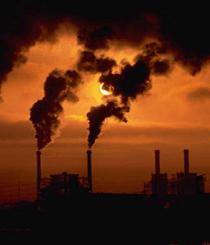 |
High Paying
US Jobs, Economic
Empowerment
&
Revitalization
of
States through Federal Power |
"Critical Field"
Technology Innovation
&
Maximized Profits on
R&D and Investments |
Prevention of Biochemical
and Nuclear Proliferation
&
Homeland Security
Technologies |
Conversion of Dirty Coal to Pure Scented
Fuel

After reviewing the process our experts conclude that the
process, while ingenious, relies on conventional engineering practice and
because of its low temperature/low pressure nature should not represent a
significant technical risk if a commercial-sized project is undertaken.
"The leaching section of the plant represents technology well within the
boundaries of contemporary engineering design."
The process begins by reducing untreated coal to less than
2 mm by conventional reduction and screen-selection methods. The coal is then
reacted with fluorine acid. A by-product of the reaction is silicon
tetrafluoride (SiF4) gas, which is processed through a hydrolyzer to
produce silica (SiO2) and fluosilicic acid (H2SiF6).
The reacted coal is sent to a separator, which separates iron sulfide (
FeS
) and other heavy metals. The remaining mixture is sent to a solids-liquids
separation (Filter 1). Filtered acids and silicon tetrafluoride gas is sent to
the acid plant for reprocessing. The filtered and treated coal product is washed
with aqueous fluosilicic acid (H2SiF6). The resulting
mixture is once again filtered (Filter 2) and then sent to a dryer where it is
flash baked at temperatures between 250°C to 400°C to remove any remaining
hydrofluorsilicic acid from the coal product. Any liberated hydrogenfluoride and
silicon tetrafluorine gas is sent to the acid plant for processing back into
useful fluorine acid. After drying, the resulting product is a light,
free-flowing granular material which can easily be conveyed pneumatically via
pipeline or conveniently stored and shipped via rail. It is essentially ash free
and thus joins natural gas and fuel oils in the family of fuels requiring no ash
handling facilities in the boiler, or precipitation or filtration plant in the
stack. Because the product is relatively ash free it can be used in a highly
efficient combined-cycle power plant operation (potentially over 50% efficient),
resulting in much lower CO2 emissions (greenhouse gas) when compared
to conventional coal-fired power plants having 30-40% efficiency.
Heat for the drying process is provided by the exhaust of
a gas turbine. The gas turbine can be fueled either by the product or natural
gas. For a typical sized plant (500,000 metric tons of the product/year) the
on-site gas turbine would be sized for 27 MW of production, with 2 MW consumed
by the plant itself, producing a 25-MW net electric production available for
sale to the electric grid. Approximately 10% of the output would be needed to
fire the gas turbine.

·
Patented
and proven clean process that chemically refines all types of coal and coal
waste before combustion into 99.7% + pure hydrocarbon fuel, used as a feedstock
for fuel cells, combusted in conventional electrical power generation, or used
in captive industrial boilers and other applications, virtually eliminating SOx,
NOx, Hg and ash
·
Produces
clean fuel priced 30% below natural gas, without price volatility, enabling coal
producers to compete with natural gas on an economic and environmental basis, in
boilers, turbines and other applications (much less expensive than scrubbers in
coal fuel generation)
·
Positioned
to dominate the $30 billion fossil fuel power generation market, which is
expected to double over the next 20 years
·
Eliminates
need for expensive scrubbers, precipitators, bag houses, ash handlers and other
pollution control equipment (which can cost more than $200 million for a $900
million power plant)
·
Early
revenue through licensing
·
Projected
revenues exceeding $100 million and EBITDA exceeding $30 million in 2005, before
upside from sale of emission and carbon credits
·
Enables
environmental rehabilitation of coal waste/slurry ponds
·
With
90% of
U.S.
energy reserves in coal, and 52% of current power production from coal,
enhances
U.S.
energy security
Near elimination of sulfur (SOx), nitrogen oxides (NOx), and
particulate emissions, including finely divided heavy-metal dusts. This would
reduce or eliminate the acid content of rain and smog- and haze-forming
atmospheric pollutants, lessening the detrimental effects of particulates on
crop yields, forest productivity and the health of humans and livestock.
Reduces land-use requirements to dispose of clinker and fly
ash, which result from traditional coal-fired plants.
Reduces carbon dioxide (CO2) emissions resulting from
increased power generation efficiencies.
Eliminates the need for additional pollution-control measures.
Combustion temperatures can be held below the threshold for NOx formation. The
minimal fly-ash emissions are free of biotoxic heavy-metal oxides and carbonyls.
By removing and recovering the ash minerals before combustion, the product
avoids the land-use consequences of conventional-coal power station
technologies.
Stops surface water pollution by eliminating the precipitation
of airborne wastes, and lechates from solid-waste disposal areas.
Complies with the most severe emission standards set for new
power stations. Specifically, it will meet the standards set by the Australian
Environment Council, National Health and Medical Research Council, the
Umweltbundesamt for Germany, the U.S. Environmental Protection Agency, and
individual states such as California. The most stringent standards are between
160mg and 270mg SO2/m3, 80-540mg NO2/m3 and 35-50mg/m3 for particulates if the
Swedish standards are used, or 740-1480 SO2/m3, 615-980mg NO2/m3 and 40-125mg/m3
particulates if U.S. standards are followed.
Contains an absolute maximum of 0.3% ash, consisting almost
entirely of oxides of aluminum, silicon and titanium. The resulting flue-gas
emissions will be environmentally benign, and below ambient levels of
atmospheric particulates.
Reduces or eliminates the most toxic metal-oxide emissions
that are produced in the vapor phase at stack gas temperatures which cannot be
removed by the electrostatic precipitators or bag houses customarily used to
recover fly-ash in today's power plants.
Increased power-plant efficiency resulting from the use of
the product in gas turbines and combined-cycle electric power generation
technologies. A power plant can achieve thermal efficiencies of 51% or
more in combined-cycle power generation, instead of 31-33%, which is typical of
conventional coal-fired units equipped with high intensity fly-ash removal and
flue-gas desulfurization equipment.
Reduction in coal consumption per unit of power output by as
much as 55%, with corresponding reductions in total carbon dioxide emissions.


